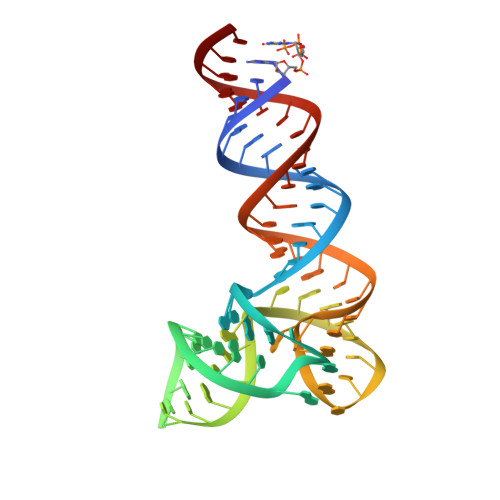Structural basis of MALAT1 RNA maturation and mascRNA biogenesis.
Skeparnias, I., Bou-Nader, C., Anastasakis, D.G., Fan, L., Wang, Y.X., Hafner, M., Zhang, J.(2024) Nat Struct Mol Biol
- PubMed: 38956168
- DOI: https://doi.org/10.1038/s41594-024-01340-4
- Primary Citation of Related Structures:
8V1H, 8V1I - PubMed Abstract:
The metastasis-associated lung adenocarcinoma transcript 1 (MALAT1) long noncoding RNA (lncRNA) has key roles in regulating transcription, splicing, tumorigenesis, etc. Its maturation and stabilization require precise processing by RNase P, which simultaneously initiates the biogenesis of a 3' cytoplasmic MALAT1-associated small cytoplasmic RNA (mascRNA). mascRNA was proposed to fold into a transfer RNA (tRNA)-like secondary structure but lacks eight conserved linking residues required by the canonical tRNA fold. Here we report crystal structures of human mascRNA before and after processing, which reveal an ultracompact, quasi-tRNA-like structure. Despite lacking all linker residues, mascRNA faithfully recreates the characteristic 'elbow' feature of tRNAs to recruit RNase P and ElaC homolog protein 2 (ELAC2) for processing, which exhibit distinct substrate specificities. Rotation and repositioning of the D-stem and anticodon regions preclude mascRNA from aminoacylation, avoiding interference with translation. Therefore, a class of metazoan lncRNA loci uses a previously unrecognized, unusually streamlined quasi-tRNA architecture to recruit select tRNA-processing enzymes while excluding others to drive bespoke RNA biogenesis, processing and maturation.
Organizational Affiliation:
Laboratory of Molecular Biology, National Institute of Diabetes and Digestive and Kidney Diseases, Bethesda, MD, USA.















